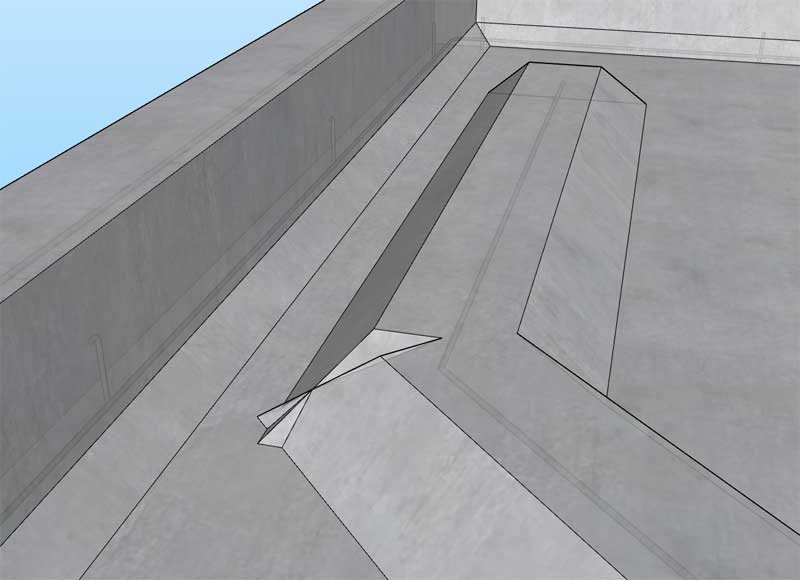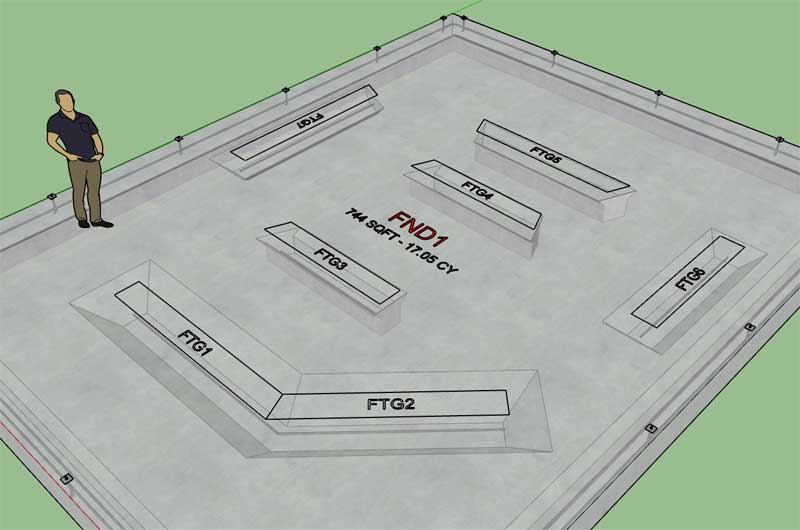Foundation Plugin
-
After mauling this over a bit more I think I can deal with the concrete, slab insulation, interior footings and subbase fairly easily with a slab depression, however the slab reinforcement is a bit more challenging. Even the footing top bars are a bit problematic ( they need to be dropped as well) as one can see in the image below:

At the moment I don't have a good answer for how to deal with slab depressions when combined with slab reinforcement. If anyone has a good idea I'm open to suggestion.
This type of slab depression (4") is fairly typical for a garage that is attached to the main residence.
View model here:
3D Warehouse
3D Warehouse is a website of searchable, pre-made 3D models that works seamlessly with SketchUp.
(3dwarehouse.sketchup.com)
I'm not saying there are not solutions to this problem but they become very computationally expensive (ie. boolean subtraction) and are not at all optimal.
-
-
A website typo, please check it now...
Thank-you for promptly bringing this to my attention.
-
Tutorial 3 - Interior Footings for Slab-on-Grade Foundations (16:33 min.)
Interior footings for rectangular slab-on-grade foundations is identical to working with polygon shaped foundations.
-
First look at the slab depression toolbar:

This toolbar will allow the user to add, delete, edit or modify slab depressions within slab-on-grade or slab foundations.
-
BUG REPORT: I'm missing a transform in the "Add Interior Footing" tool, so if a foundation is created in a location other than the origin, it may produce an unexpected result (ie. shifted footing location). I am working on the fix currently. Funny that I never exposed this error in my testing or even in the tutorial video, it does take a special set of circumstances.
I've also identified another issue where two footings might be coincident at their ends (start or end) at a non-orthogonal angle, see image below:

In such a situation rather than sloping the ends of the footing towards each other I need to miter the ends so that they meet cleanly. Just some additional code in the block of code that applies the slope to the footings.
If three footings or more footings were to meet at a single point then the boolean union of them would work out without a hitch, it is only when you join two footings at their ends that this scenario becomes an issue.
-
Version 1.3.0b - 07.16.2019
- Added the Slab Depression toolbar and icons.
- Enabled a 45 deg. miter option for the ends of interior footings.
- Fixed a bug with the initial positioning transforms for the interior footing draw tool.
The option for mitering is tucked into the start and end slope option. Now in addition to the Yes/No options you also can have it miter left or right (45 deg only).

This is a critical update since the transform bug was a significant issue with Version 1.3.0.
The slab depression functions/tools are still under construction and currently not functional.
-
Hmmm, you might be on to something with this.
I agree that the amount of toolbars has multiplied quite rapidly as I keep adding more features to each plugin, it does take up quite a bit of screen real estate now.
-
thanks for the efforts!
the toolbars for your extensions are becoming rather elaborate and taking up a bit of toolbar / screen space, any chance you could implement a single initiation button/icon instead and have a secondary open when the primary has been triggered, much like Fredo does some of his extensions?
-
Version 1.3.1 - 07.19.2019
- Added slab depressions for rectangular and polygon slab-on-grade foundations.
- Enabled editing, moving and deleting of slab depressions for all slab-on-grade foundations.
- When construction callouts and subbase material is enabled, the volume of the subbase material is displayed beneath the foundation label (currently only slab-on-grade foundation assemblies have this feature available).

The slab depression tool can also be used to cut thru holes into the slab, as shown.
Note that additional work still needs to be done to properly modify rebar and mesh for slab depressions. Currently there is no logic in place to modify the perimeter or slab rebar when a slab depression is utilized within a slab-on-grade foundation.
View model here:
3D Warehouse
3D Warehouse is a website of searchable, pre-made 3D models that works seamlessly with SketchUp.
(3dwarehouse.sketchup.com)
-
Tutorial 4 - Slab Depressions for Slab-on-Grade Foundations (9:35 min.):
View model here:
3D Warehouse
3D Warehouse is a website of searchable, pre-made 3D models that works seamlessly with SketchUp.
(3dwarehouse.sketchup.com)
-
Trying to take a day off from the programming but my mind keeps coming back to it and the brick ledge module (for slab-on-grade foundations) I have left unfinished.
Giving it a bit of thought this afternoon and I've come up with the following parameters:
-
Ledge Width
-
Ledge Height
-
Start Ext.: Defaults to zero
-
End Ext.: Defaults to zero
Really not much to it, or so it would seem.
The idea is to be able to create a brick ledge on any specified edge (perimeter) of the foundation rather than around the entire foundation. A lot of modern designs only utilize a brick facade on the front of the house and not on the rear so this ability to be selective with each wall is critical.
Once I have this feature up and running I think the tools afforded the slab-on-grade type of foundation will allow it to be utilized for most designs however additional work will still need to be done to make the rebar placement correct in a complex design.
-
-
First look at brick ledges combined with a slab depression (garage).

The trickiest part of the brick ledge module was the tool that selects the foundation edge. I have it working stably now but I need to add some additional logic which prevents the user from duplicating a brick ledge along the same foundation edge.
I also need to add in some additional logic which offsets the anchor bolts the appropriate amount given the width of the brick ledge.
Similar to the slab depressions the brick ledge module makes no accommodations currently for rebar placement. The logic and algorithms for that will take some considerable effort.
-
Here is slight modification where the slab depression is lower than the brick ledge:

-
Version 1.3.2 - 07.22.2019
- Added brick ledges for rectangular and polygon slab-on-grade foundations.
- Enabled editing, and deleting of brick ledges for all slab-on-grade foundations.
- Added an additional layer for hidden geometry into the Layers tab of the Global Settings.
-
Tutorial 5 - Brick Ledges for Slab-on-Grade Foundations (14:11 min.):
-
I am seriously considering adding the ability to slope the slab depression and would actually like to work on it before I move back to the complex roof module.
I have a few questions:
1.) With a sloping floor do you typically measure the depression from the high side as your reference and then slope it downward? Or do you measure where you want the doors to end up and then slope upwards?
2.) What is a typical slope in a garage slab depression? Is a 1/4" per foot typical? On a 24' deep garage this would mean a vertical difference of 6 inches from front to back. This seems like a pretty steep slope.
3.) If a depression is sloped then I would assume that the slab thickness in the depressed region would remain a constant thickness and hence the bottom of the slab at this region would also slope?
-
I normally set the top of the depression at 3-1/2" below the main slab (a 2x4 for the form) and 5-1/2" below the main slab at the garage doors (a 2x6 for the form); if the garage is deeper than - say - 24' I would probably slope to a central location and add a drain inlet. Stems higher than 5-1/2" would need to be increased in width for me to be comfortable that they would be stable.
-
@mtnarch said:
I normally set the top of the depression at 3-1/2" below the main slab (a 2x4 for the form) and 5-1/2" below the main slab at the garage doors (a 2x6 for the form); if the garage is deeper than - say - 24' I would probably slope to a central location and add a drain inlet. Stems higher than 5-1/2" would need to be increased in width for me to be comfortable that they would be stable.
Rather than prompt the user for a pitch/percent grade or some other angle I think it would be easier just to have them specify a height differential. So if the primary depth of the depression is 3.5" at the back of the garage and then the user calls out a differential of 2" then the other side of the depression will be 5.5" at the door.
-
Version 1.3.3 - 07.24.2019
- Enabled sloping slab depressions for rectangular and polygon slab-on-grade foundations.
- Fixed a bug with the slab depression draw tool.

The sloping of the depression can be either in the X or Y direction, in the future I may allow for other directions. To reverse the slope, the slope differential can be entered in as a negative number in the edit or draw menu.
Advertisement










